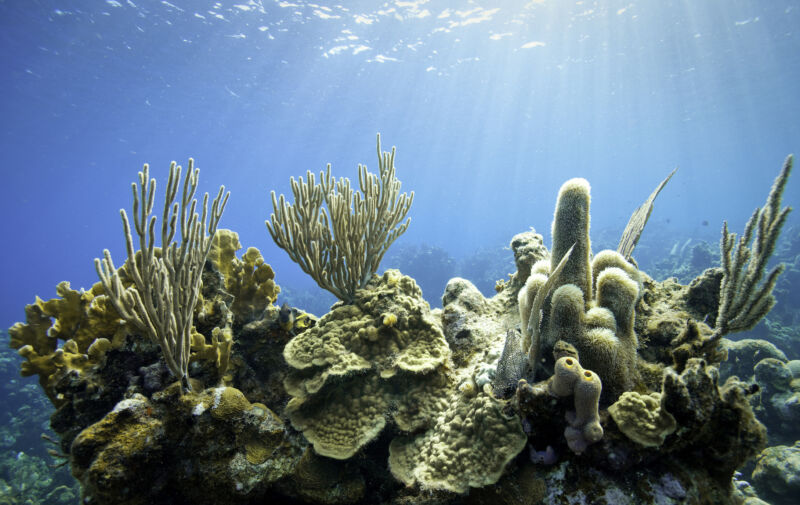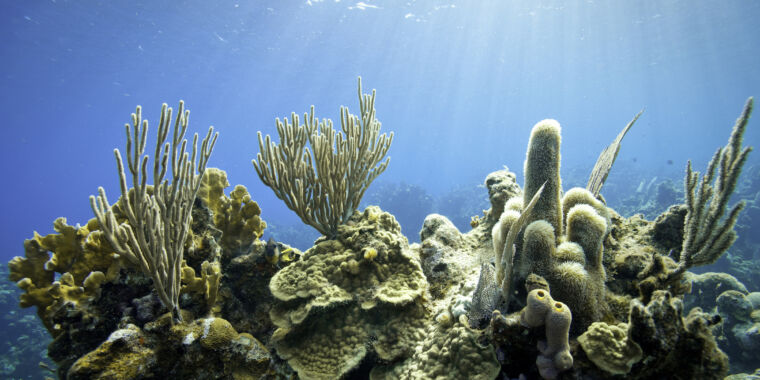
Medical authorities have spent years convincing people to use sunscreen to limit their exposure to UV light. But that effort has had a bit of a setback, as several locations have recently banned the use of sunblocks by beachgoers. Those bans took effect after local waters were found to have high levels of some of the chemicals in sunblock, which was associated with the lower health of nearby coral reefs.
Several studies have indicated that one specific sunblock component, a chemical called oxybenzone, is at the root of the problem. But the mechanism by which oxybenzone could harm corals wasn’t clear. And, without that understanding, it’s difficult to tell which sunblocks might pose a risk.
Now, researchers from Stanford University have identified the problem. The corals convert oxybenzone from a chemical that can harmlessly absorb UV light to one that damages biological molecules after being exposed to UV. And there’s evidence that coral bleaching makes matters worse, as the coral is less able to withstand exposure.
This shouldn’t be a problem
Rather than working with corals, which are slow-growing, the researchers did most of their work on its evolutionary relative, the anemone. And they started simply by confirming that oxybenzone was a problem in these organisms, too, by testing growth under various conditions. Healthy anemones exposed to a day-night light cycle that included UV light grew well. But add in oxybenzone, and it took just over two weeks for all the anemones to die.
Oddly, however, oxybenzone without the day-night cycle did not affect anemone survival. It took both the chemical and UV light to kill the animals. This result doesn’t make a lot of sense. We use oxybenzone as a sunblock precisely because it manages to dissipate the energy from UV radiation harmlessly. Yet, in these animals, UV was turning the chemical into a killer.
So, the researchers hypothesized that oxybenzone wasn’t the killer. Many chemicals, once inside cells, come in contact with enzymes that catalyze reactions with them, resulting in a related yet distinct chemical. In some cases, this is because the enzymes are used to detoxify a range of related chemicals. In other cases, it’s an accident caused by two chemicals just looking sufficiently similar. Whatever the reason, the chemical that goes into cells may not be the chemical altering the cells’ behavior (this is often the case with drugs).
To find out whether that was the case here, the researchers exposed anemones to oxybenzone for 18 hours, ground them up, and looked for any related chemicals in their contents. Most of the chemical, they found, had ended up with glucose attached to it.
In test tubes, oxybenzone doesn’t engage in any reactions that seem to damage biomolecules. But once the glucose is attached, UV light leads the glucose-linked form to chemically alter a couple of biomolecules. And it did so catalytically, meaning none of the glucose-oxybenzone was consumed in the process. That means it doesn’t take much to do considerable damage.
It gets worse
While looking for the chemical derivatives of oxybenzone, the researchers noticed that much of the material wasn’t in the anemone cells; instead, it was found in the symbiotic microorganisms associated with the anemone. This finding suggested, to an extent, that the presence of the symbiotes protected the anemones from the toxic effects of the modified oxybenzone.
To confirm this, they turned to a coral species that can undergo bleaching, meaning the loss of its microbial symbiotes. When they were present, the symbiotes took up enough of the glucose-oxybenzone to completely protect the coral from any lethal effects of UV radiation (in fact, any oxybenzone that remains unmodified probably provides some protection). But in a bleached version of the same coral, the glucose-oxybenzone is once again lethal. This result raises the risk that sunscreen is especially dangerous in the wake of a coral bleaching event.
The researchers suggest that this is all probably a big accident. The enzyme that adds the glucose to this chemical probably evolved as a way to simply make toxins more soluble and thus easier to get rid of. And the fact that oxybenzone is great at absorbing UV light makes it a great sunscreen and more likely to use that energy in unfortunate ways once it’s modified.
The good news is that, now that we’ve identified the mechanism at play, we have a better chance of detecting other chemicals that could cause similar problems. That knowledge could allow us to design sunscreens that are less likely to have these unexpected side effects.
Science, 2022. DOI: 10.1126/science.abn2600 (About DOIs).








